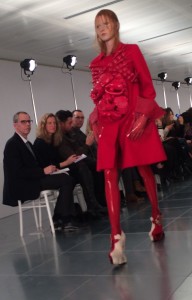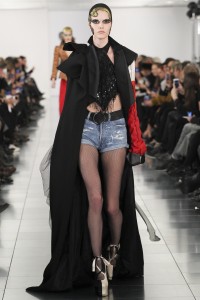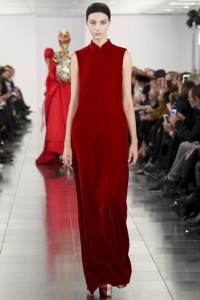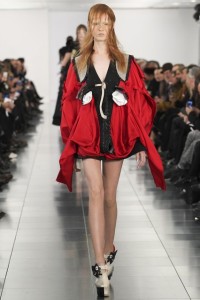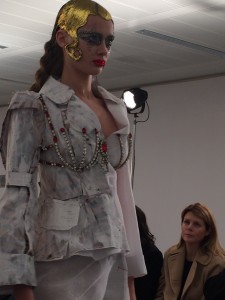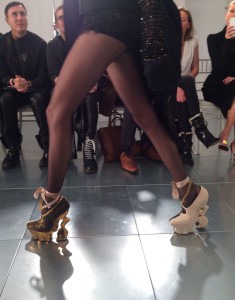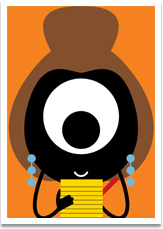Maison Margiela takes off its mask to reveal Galliano.
With exquisite attention to detail, wild splashes of scarlet and intense decoration set against pure tailoring, John Galliano came back to the runway.
The renowned designer, disgraced by anti-semitic remarks, stepped out for a micro-second in a white lab coat at the end of his show for Maison Margiela, to generous applause for the models parading to the music of “Hey, Big Spender” – maybe a touch of irony at this first couture showing of the new season.
The designer’s friends, fans and colleagues were willing to forgive, if not forget, and the sheer excellence and originality of Galliano’s work brought appreciative applause from Kate Moss, who said “that red dress gave me the shivers”; Alber Elbaz of Lanvin, who had sent the designer a box of crayons and pencils; and Manolo Blahnik, who was decidedly not the supplier of platform shoes whose thick heels were carved like giants’ teeth.
There was something raw and animalistic about an outfit where 3D eyes glowed at the waist or a breastpiece which looked like the sparking remnants from a queen’s bottom drawer. A crown and skeletal teeth topped that outfit.
Yet somehow, in the mix of oddities and remnants – presumably a nod to Martin Margiela’s idea of remake-and-mend – there was a sweet elegance. Another plain red velvet dress, cut away in curving, flesh-revealing spaces at the back, had the fashion audience sighing and dying, with Natalie Massenet of Net-a-porter the first to sing its merits and show her desire.
Then there were streamlined but seductive black trouser suits. This being Galliano, many pieces had a sexual message, as a black dress, set at a cutaway angle, revealed the kind of teeny-weeny denim shorts that would accompany Kate Moss to Glastonbury.
Just when we thought we had seen it all, out came elegant evening outfits with floating chiffon and shapely transparency that took the audience back to Galliano’s Dior days.
Without measuring how much of this show was designed as Galliano and how much for the Maison Margiela label, both were definitely present.
“I’ve never seen anything like this in my life – every outfit tells a story and we have been working for six months – so much time on each one,” said Renzo Rosso of Diesel, whose aptly named Only the Brave company is behind Maison Margiela, as well as Marni and Viktor & Rolf.
For those of us who lived through the great years of both Galliano and Margiela, the memories threatened to submerge the reality of this show held in the ultra-modern glass building in London.
My first memories of Margiela were of a wasteground on the edge of Paris, where a crowd of curious North African children gathered to watch this show of clotes – all presented inside their plastic dry-cleaner bags.
For Galliano it was Les Incroyables – the fashion inhabitants of the French Revolution of the 1790s – clothes of a wild and wonderful madness that were part of his Saint Martin’s graduation show in 1984 that immediately went on sale at Browns boutique.
Martin Margiela – Belgian, serious, the antithesis of extravagance and showing off – is the first designer I can remember talking of re-cycling at the sunset of the orgy of opulence and extravagance that was the Eighties. One of his shows was even staged at an indoor flea market, and I believe he told me that suits he showed were made over from his father’s or grandfather’s tweeds.
Galliano, of Spanish origin, came up with a down-and-out makeover at Dior, inspired by the clochards or homeless people along the borders of the Seine. The skills of the famous petites mains used to create worn and destroyed-looking clothes caused outrage in Paris.
All of us who remember John when he was more or less down and out himself, but could create magic from nothing, think of 21 years ago, when Sao Schlumberger, the Portuguese-born art-lover and socialite, loaned Galliano her empty Paris mansion. John, with his then muse Amanda Harlech, created a fairy-like presentation of a few outfits around a shattered chandelier, lying in a pool on the floor like a symbol of broken dreams.
By 1995 – now 20 years ago – Galliano was creative director at Givenchy and went on to bring his extravagant magic to Dior. The swashbuckling outfits in which the designer took his bow each season were part of catwalk theatre.
Meanwhile, Martin Margiela, his head covered in a pull-on hat, was mostly invisible and always silent (although to my shame, he once criticised me in the early days for misquoting him). The shows were cerebral, inventive, often brilliant – like the twin shows in white and black, in separate venues, one in the dark and the other in candlelight.
Margiela’s talent was never snuffed out – he just stepped away from the company after Renzo Rosso had bought it and the designer felt that he had nothing more to say.
Galliano may not have so much new to say either. But what he showed in London was a powerful mix of beauty, low-level provocation and the skills he has learned over the years.
In an era when fashion’s high tide is ebbing, as a wave of dull normality rolls forward, the return of John Galliano to the catwalk must be welcomed by anyone who loves the glory of the extraordinary.



